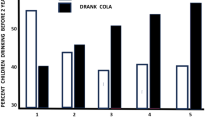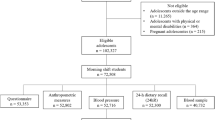Abstract
Background/Objectives:
In parallel with the obesity epidemic, consumption of sugar-sweetened beverages (SSB) has risen over the same period. Our aim was to investigate associations between the consumption of SSB in childhood and adolescence with subsequent changes in body fatness in early adulthood.
Subjects/Methods:
A longitudinal study of 9-year-old children (n=283) enrolled in the Danish part of the European Youth Heart Study with a 6-year and 12-year follow-up. Data were collected at ages 9, 15 and 21 years. Multivariate regression analyses with adjustment for potential confounders were used to evaluate the effect of SSB consumption at 9 and 15 years and change in SSB consumption from 9–15 years on subsequent change in body fatness until 21 years.
Results:
Subjects who consumed more than one serve of SSB daily at age 15 years had larger increases in body mass index (BMI) (β=0.92, P=0.046) and waist circumference (WC) (β=2.69, P=0.04) compared to non-consumers over the subsequent 6 years. In addition, subjects who increased their SSB consumption from age 9–15 years also had larger increases in BMI (β=0.91, P=0.09) and WC (β=2.72, P=0.04) from 15–21 years, compared to those who reported no change in consumption. No significant association was observed from 9–21 years.
Conclusion:
This study provides new evidence that SSB consumption in adolescence and changes in SSB consumption from childhood to adolescence are both significant predictors of change in body fatness later in early adulthood.
This is a preview of subscription content, access via your institution
Access options
Subscribe to this journal
Receive 12 print issues and online access
$259.00 per year
only $21.58 per issue
Buy this article
- Purchase on Springer Link
- Instant access to full article PDF
Prices may be subject to local taxes which are calculated during checkout


Similar content being viewed by others

References
Popkin BM, Nielsen SJ . The sweetening of the world's diet. Obes Res 2003; 11: 1325–1332.
Malik V, Schulze M, Hu F . Intake of sugar-sweetened beverages and weight gain: a systematic review. Am J Clin Nutr 2006; 84: 274–288.
Woodward-lopez G, Kao J, Ritchie L . To what extent have sweetened beverages contributed to the obesity epidemic? Public Health Nutr 2010; 14: 499–509.
Te Morenga L, Mallard S, Mann J . Dietary sugars and body weight: systematic review and meta-analyses of randomised controlled trials and cohort studies. BMJ 2013; 346: e7492.
Ludwig DS, Peterson K, Gortmaker S . Relation between consumption of sugar-sweetened drinks and childhood obesity: a prospective, observational analysis. Lancet 2001; 357: 505–508.
Berkey C, Rockett H, field A, Gillman M, Coldirz G . Sugar-added beverages and adolescent weight change. Obes Res 2004; 12: 778–788.
Schulze MB, Manson JE, Ludwig DS, Colditz GA, Stampfer MJ, Willett W et al. Sugar-sweetened beverages, weight gain, and incidence of type 2 diabetes in young and middle-aged women. Am Med Assoc 2004; 292: 927–934.
de Ruyter J, Olthof M, Seidell J, Katan M . A trial of sugar-free or sugar-sweetened beverages and body weight in children. N Eng J Med 2012; 367: 1397–1406.
Ebbeling C, Feldman H, Chomitz V, Antonelli T, Gortmaker S, Osganian S et al. A randomized trial of sugar-sweetened beverages and adolescent body weight. N Eng J Med 2012; 367: 1407–1416.
Maersk M, Belza A, Stødkilde-Jørgensen H, Ringgaard S, Chabanova E, Thomsen H et al. Sucrose-sweetened beverages increase fat storage in the liver, muscle, and visceral fat depot: a 6-mo randomized intervention study. Am J Clin Nutr 2012; 95: 283–289.
Mattes R, Shikany J, Kaiser K, Allison D . Nutritively sweetened beverage consumption and body weight: a systematic review and meta-analysis of randomized experiments. Obes Rev 2011; 12: 346–365.
Gibson S . Sugar-sweetened soft drinks and obesity: a systematic review of the evidence from observational studies and interventions. Nutr Res Rev 2008; 21: 134–147.
Pereira M . The possible role of sugar-sweetened beverages in obesity etiology: a review of the evience. Int J Obes 2006; 30: S28–S36.
Bellisle F, Drewnowski A . Intense sweeteners, energy intake and the control of body weight. Eur J Clin Nutr 2007; 61: 691–700.
Banchman C, Baranowski T, Nicklas T . Is there an association between sweetened beverages and adiposity? Nutr Rev 2006; 64: 153–174.
Bray G, Nielsen S, BM P . Consumption of high-fructose corn syrup in beverages may play a role in the epidemic of obesity. Am J Clin Nutr 2004; 79: 537–543.
Olsen N, Andersen LB, Wedderkopp N, Kristensen P, Heitmann B . Intake of liquid and solid sucrose in relation to changes in body fatness over 6 years among 8- to 10-year-old children: The European Youth Heart Study. Obes Facts 2012; 5: 506–512.
Kelliny C, Ekelund U, Anderson L, Brage S, Loos R, Wareham N et al. Common genetic determinants of glucose homeostatis in healthy children: The European Youth Heart Study. Diabetes 2009; 58: 2939–2945.
Riddoch C, Edwards D, Page A, Froberg K, Anderssen S, Wedderkopp N . The European Youth Heart Study-cardiovascular disease risk factor in children: rationale, aims, study design, and validation of method. J Phys Act Health 2005; 2: 115–129.
Hare-Bruun H, Nielsen B, Kristensen P, Moller N, Togo P, Heitmann B . Television viweing, food preferences, and food habits among children: A prospective epidemiological study. BMC Public Health 2011; 11: 311.
Cole T, Bellizzi M, Flegal K, Dietz W . Establishing a standard definition for child overweight and obesity worldwide: international survey. BMJ 2000; 320: 1240–1243.
Nielsen BM, Bjornsbo KS, Tetens I, Heitmann BL . Dietary glycaemic index and glycaemic load in Danish children in relation to body fatness. Br J Nutr 2005; 94: 992–997.
Lytle LA, Nichaman MZ, Obarzanek E, Glovsky E, Montgomery D, Nicklas T et al. Validation of 24-hour recalls assisted by food records in third-grade children. The CATCH Collaborative Group. J Am Diet Assoc 1993; 93: 1431–1436.
Danish Institute for Food and Veterinary Research, Ministry of Family and Consumer Affairs. Danish Food Composition Databank. DFVR: Søborg, Denmark, 2006.
Goldberg GR, Black AE, Jebb SA, Cole TJ, Murgatroyd PR, Coward WA et al. Critical evaluation of energy intake data using fundamental principles of energy physiology: 1. Derivation of cut-off limits to identify under-recording. Eur J Clin Nutr 1991; 45: 569–581.
Schofield WN . Predicting basal metabolic rate, new standards and review of previous work. Human nutrition. Clin Nutr 1985; 39 (Suppl 1), 5–41.
Tanner J . Normal growth and techniques of growth assessment. Clin Endocrinol Metab 1986; 15: 411–451.
Groth M, Fagt S, Brùndsted L . Social determinants of dietary habits in Denmark. Eur J Clin Nutr 2001; 55: 959–966.
Gungor N, Saad R, Janosky J, Arslanian S . Validation of surrogate estimates of insulin sensitivity and insulin secretion in children and adolescents. J Pediatr 2004; 144: 47–55.
Katz M . Multivariable Analysis: A Practical Guide for Clinicians. Cambridge University Press: New York, 1999.
Viner RM, Cole TJ . Who changes body mass between adolescence and adulthood? Factors predicting change in BMI between 16 year and 30 years in the 1970 British Birth Cohort. Int J Obes (Lond) 2006; 30: 1368–1374.
Tam C, Garnett S, Cowell C, Campbell K, Cabrera G, Baur L . Soft drink consumption and excess weight gain in Australian school students: results from the Nepean study. Int J Obes 2006; 30: 1091–1093.
Fiorito L, Marini M, Francis L, Smiciklas-Wright H, Birch L . Beverage intake of girls at age 5 y predicts adiposity and weight status in childhood and adolescence. Am J Clin Nutr 2009; 90: 935–942.
Kral T, Stunkard A, Berkowitz R . Beverage consumption patterns of children born atdifferent risk of obesity. Obesity 2008; 16: 1802–1808.
Lim S, Zoellner J, Lee J, Burt B, Sandretto A, Sohn W et al. Obesity and sugar-sweetened beverages in African-American preschool children: a longitudinal study. Obesity 2009; 17: 1262–1268.
Bertheke Post G, de Vente W, Kemper H, Twisk J . Longitudinal trends in and tracking of energy and nutrient intake over 20 years in a Dutch cohort of men and women between 13 and 33 years of age: The Amsterdam Growth and Health Longitudinal Study. Br J Nutr 2001; 85: 375–385.
Mikkilä V, Raäsaänen L, Raitakari O, Pietinen P, Viikari J . Consistent dietary patterns identified from childhood to adulthood: the cardiovascular risk in Young Finns Study. Br J Nutr 2005; 93: 923–931.
Nissinen K, Mikkilä V, Männistö S, Lahti-Koski M, Räsänen L, Viikari J et al. Sweets and sugar-sweetened soft drink intake in childhood in relation to adult BMI and overweight. The Cardiovascular Risk in Young Finns Study. Public Health Nutr 2009; 12: 2018–2026.
Welsh JA, Cogswell ME, Rogers S, Rockett H, Mei Z, Grummer-Strawn LM . Overweight among low-income preschool children associated with the consumption of sweet drinks: Missouri, 1999–2002. Pediatrics 2005; 115: e223–e229.
Striegel-Moore R, Thompson D, Affenito S, Franko D, Obarzanek E, Barton B . Correlates of beverage intake in adolescent girls: the National Heart, Lung, and Blood Institute Growth and Health Study. J Pediatr 2006; 148: 183–187.
Brand-Miller J, Holt S, Pawlak D, McMillan J . Glyceamic index and obesity. Am J Clin Nutr 2002; 76: 218S–285S.
Janssens JP, Shapira N, Debeuf P, Michiels L, Putman R, Bruckers L et al. Effects of soft drink and table beer consumption on insulin response in normal teenagers and carbohydrate drink in youngsters. Eur J Cancer Prev 1999; 8: 289–295.
Wang Y . Is obesity associated with early sexual maturation? A comparison of association in American boys versus girls. Pedatrics 2002; 110: 903–910.
Heitmann B, Lissner L . Dietary underreporting by obese individuals—is it specific or non-specific? BMJ 1995; 311: 986.
Acknowledgements
LBA was responsible for collection of data, except diet data for which BLH was responsible. NJO calculated the sugar fractions. BLH conceived the hypothesis for the study, MZ analysed data; BLH, MZ and AR interpreted data, wrote the manuscript and reviewed/edited the manuscript. All authors reviewed/edited the final manuscript. We thank all those involved with the European Youth Heart Study.
Author information
Authors and Affiliations
Corresponding author
Ethics declarations
Competing interests
The authors declare no conflict of interest.
Additional information
Supplementary Information accompanies this paper on the European Journal of Clinical Nutrition website
Supplementary information
Rights and permissions
About this article
Cite this article
Zheng, M., Rangan, A., Olsen, N. et al. Sugar-sweetened beverages consumption in relation to changes in body fatness over 6 and 12 years among 9-year-old children: the European Youth Heart Study. Eur J Clin Nutr 68, 77–83 (2014). https://doi.org/10.1038/ejcn.2013.243
Received:
Revised:
Accepted:
Published:
Issue Date:
DOI: https://doi.org/10.1038/ejcn.2013.243
Keywords
This article is cited by
-
The negative impact of sugar-sweetened beverages on children’s health: an update of the literature
BMC Obesity (2018)
-
Characteristics associated with the consumption of malted drinks among Malaysian primary school children: findings from the MyBreakfast study
BMC Public Health (2015)
-
Is Sugar the new Tobacco? Insights from Laboratory Studies, Consumer Surveys and Public Health
Current Obesity Reports (2015)
-
Role of Childhood Food Patterns on Adult Cardiovascular Disease Risk
Current Atherosclerosis Reports (2014)


